Related Research Articles

George Albert Boulenger was a Belgian-British zoologist who described and gave scientific names to over 2,000 new animal species, chiefly fish, reptiles, and amphibians. Boulenger was also an active botanist during the last 30 years of his life, especially in the study of roses.
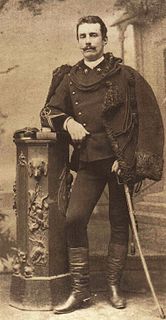
Vittorio Bottego was an Italian army officer and one of the first Western explorers of Jubaland in the Horn of Africa, where he led two expeditions. He was an artillery captain in the Italian Army.

Johann Jakob Heckel was an Austrian taxidermist, zoologist, and ichthyologist from Mannheim in the Electoral Palatinate.

Reganochromis calliurus is a species of cichlid endemic to Lake Tanganyika in East Africa. It lives over a sandy substrate in deeper coastal waters, to depths of at least 60 m (200 ft). Its preferred diet consists mostly of shrimp. It can reach a total length of 15 cm (5.9 in). This fish can also be found in the aquarium trade. It is currently the only known member of its genus.
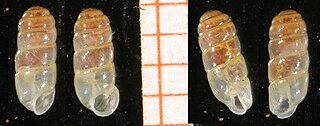
Gulella is a genus of very small air-breathing land snails, terrestrial pulmonate gastropod mollusks in the family Streptaxidae.
Enteromius greenwoodi is a species of ray-finned fish in the genus Enteromius from Angola.
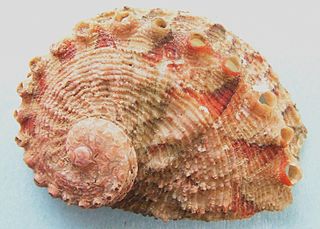
Haliotis queketti, common name Quekett's abalone, is a species of sea snail, a marine gastropod mollusk in the family Haliotidae, the abalones.

Pseudocrenilabrus nicholsi is a species of cichlid native to the Congo Basin in Africa. As other members of the genus Pseudocrenilabrus, it is a mouthbrooder. This species can reach a length of 8.5 centimetres (3.3 in) SL. The specific name honours the American ichthyologist John Treadwell Nichols (1883-1958) who was curator of fishes at the American Museum of Natural History. Nichols originally described this species as Paratilapia ventralis in 1928 but this name had already been used by George Albert Boulenger for another species of cichlid in 1898.
Neoclinus stephensae, the Yellowfin fringehead, is a species of chaenopsid blenny found in the eastern Pacific ocean. It can reach a maximum length of 10 centimetres (3.9 in) TL. The specific name honours the collector of the type, the British-American conchologist Kate Stephens who was Curator of Mollusks and Marine Invertebrates at San Diego Natural History Museum and who was over 100 years old at the time the species was described.

Fundulopanchax is a genus of killifish living in near-coastal fresh water streams and lakes in Western Africa. All species were previously biologically classified as members of the genus Aphyosemion, with the exception of Fundulopanchax avichang, F. gresensi and F. kamdemi, which were all scientifically described after the major revision of the Aphyosemion complex.
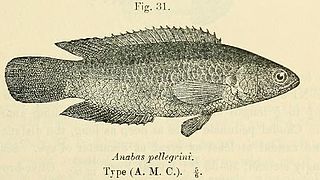
Ctenopoma pellegrini is a fish in the family Anabantidae found in the Congo River basin of Africa. It grows to 11.2 cm in total length for a male/unsexed specimen. This species was formally described by the British-Belgian ichthyologist George Albert Boulenger in 1902 with the type locality given as Yembe River at Banzyville in the Democratic Republic of Congo. Boulenger honoured the French ichthyologist Jacques Pellegrin (1873-1944).
Gerald Robert "Gerry" Allen is an American-born Australian ichthyologist. His career began in 1963, when he spent a semester at the University of Hawaii, where he also received a PhD in marine zoology in 1971. In 1972, Allen wrote his doctoral thesis on the systematics and biology of the anemone fish.
The lesser gurnard, or Quekket’s gurnard, is a is a species of marine ray-finned fish belonging to the family Triglidae, the gurnards and sea robins. This species is found in the southwestern Indian Ocean and marginally in the southeastern Atlantic Ocean. This species is of commercial importance as a food fish.

Yongeichthys is a genus of gobies native to the coastal waters of the Atlantic coast of Africa, Indian Ocean and the western Pacific Ocean. The name of this genus honours the zoologist Charles Maurice Yonge (1899-1986), who led the Great Barrier Reef Expedition of 1928–1929.
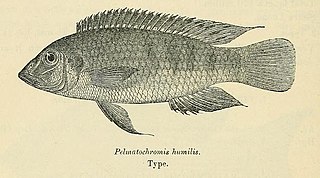
Wallaceochromis is a genus of fish in the family Cichlidae and subfamily Pseudocrenilabrinae endemic to West Africa. The name of this genus honours the British naturalist and coproponent of the theory of evolution through natural selection, Alfred Russel Wallace (1823–1913).

Jaydia queketti, the spotfin cardinal or signal cardinalfish, is a species of ray-finned fish from the Indian Ocean, it is a member of the family Apogonidae. It has colonised the eastern Mediterranean Sea by way of the Suez Canal since 2004.

Kate Stephens was an American naturalist and the Curator of Mollusks and Marine Invertebrates at the San Diego Natural History Museum from 1910 to 1936.
Helen K. Larson is an ichthyologist who specialises in the fishes of the Indo-Pacific.
William Leonard Stevenson Loat, the son of William L. and Marianna Eliza Stevenson. was a British archaeologist, naturalist and collector. Many of the objects he had collected from China, Egypt, Peru, Africa, Australia, Assam, Polynesia and North America were bequeathed to the British Museum in 1920 while her also donated some Australian items to the Plymouth City Museum. He often worked on excavations with Flinders Petrie, as well as being a member of the Egypt Excavation Fund. At some point he directed the excavations at Abydos. He first travelled to Egypt in 1899 as an assistant to the zoologist George Albert Boulenger of the British Museum on an ichthyological survey of the Nile. Later he took part in excavations at Gurob in 1903 for Petrie and at Abydos for the Egypt Excavation Fund in 1908-9 and 1912–13, He was responsible for finding and publishing a description of the Ibis Cemetery. The outbreak of the First World War in 1914 meant that he had to cease working in Egypt. He the married andtook residence at Mevagissy, Cornwall where he pursued an interest in horticulture. He travelled to the Andes in 1927 and during the 1920s he presented some Egyptian objects to the Penzance Museum.
Phillip Clarence Heemstra was an American-South African ichthyologist. He was born in Melrose Park, Illinois, United States as the son of Clarence William Heemstra and his wife, Lydia. He attended school in Ottawa, Illinois, and completed a B.Sc. Zoology in 1963 at the University of Illinois at Urbana, Illinois, as well as his MSc degree (1968) and doctorate (1974) in marine biology at the University of Miami in Miami, Florida. He moved to live in South Africa in 1978.
References
- ↑ "Who are we? The Quekett Microscopical Club". Quekket Microscopical Club. Retrieved 12 June 2022.
- 1 2 3 4 5 6 "Quekett, Mr John Frederick Whitlie (conchology, museum curation)". S2A3 Biographical Database of Southern African Science. Retrieved 12 June 2022.
- ↑ Froese, Rainer; Pauly, Daniel (eds.) (2022). "Scylliogaleus quecketti" in FishBase . February 2022 version.
- ↑ Christopher Scharpf & Kenneth J. Lazara, eds. (10 June 2021). "Order Perciformes (Part 12): Suborder Triglioidei: Families Triglidae and Peristediidae". The ETYFish Project Fish Name Etymology Database. Christopher Scharpf and Kenneth J. Lazara. Retrieved 12 June 2022.
- ↑ Christopher Scharpf & Kenneth J. Lazara (9 May 2022). "Order KURTIFORMES (Nurseryfishes and Cardinalfishes)". The ETYFish Project Fish Name Etymology Database. Christopher Scharpf and Kenneth J. Lazara. Retrieved 12 June 2022.
- ↑ "Amietia delalandii (Duméril and Bibron, 1841)". Amphibian Species of the World 6,1. American Museum of Natural History.